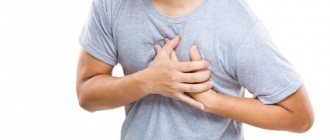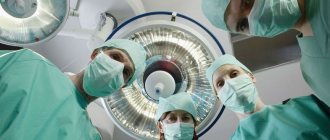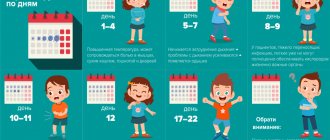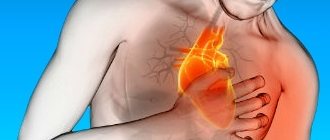Conditions in which the abdomen hurts in the navel area are grounds for contacting a therapist, surgeon or gastroenterologist. Pathologies that cause such symptoms require conservative or surgical elimination. The type of intervention depends on the identified violation, its severity, statute of limitations, location and other factors. If you refuse to seek medical help, conditions may develop in which extensive inflammation of the abdominal cavity and blood poisoning occur. In these cases, the risk of death increases.
Irritable bowel syndrome
It is characterized by the appearance of abdominal pain, which is caused by increased intestinal motility, as well as spasms of the intestinal wall. This disorder most often manifests itself in young people who are emotionally labile.
With this disease, stools become more frequent and there is an admixture of mucus in the stool. A distinctive feature is the complete cessation of pain during sleep, when the person calms down.
Pain to the left of the navel
If pain develops in the left side at the level of the navel, you need to determine which organ is located on the lower left. On the left are the omentum, intestinal loops, ureter, and renal hilum.
Pain in this area may be due to gas accumulation. If a pathological process of the large intestine develops, then in addition to pain, stool disturbances, the appearance of mucus and blood in the stool, and an increase in temperature will be noted.
If scarlet blood appears in the stool. This means that a patient with hemorrhoids , if the stool becomes tarry, this means that bleeding is developing in the gastrointestinal tract.
Pain in the umbilical area due to irritation of the diaphragm is also possible with viral lung diseases.
Volvulus of the small intestine (jejunum)
It is a twisting of the intestinal wall in such a way that there is an obstacle to the movement of intestinal contents. The intestine seems to be tied into a “knot”. This is possible precisely in the small parts of the intestine, where the length of the mesentery allows the intestine to twist around its axis.
The person begins to feel a strong, sudden pain in the center of the abdomen near the navel. It is important to know that with intestinal volvulus, necrosis occurs quite quickly. Treatment consists of removing a section of damaged intestine and restoring integrity by creating an anastomosis (connection).
Doctor's advice
The periumbilical area is often used as a surgical approach for many operations, for example, umbilical hernia and linea alba. After surgery, many experience pain around the navel of varying intensity and duration. Some go away in 1-3 months - this is when the nerves cut during the operation grow together. Others last for years - they arise due to improper fusion of nerve endings, which are “shorted” like 2 exposed wires. Such pains eventually go away, but can manifest themselves as a reaction to changes in weather or occur during physical activity. There is no specific therapy. If there is a tendency to excessive growth of connective tissue (this is manifested by wide scars after incisions and injuries), Lidaza can be used.
Victoria Druzhikina Neurologist, Therapist
Pain in the umbilical region in women
Patients who consult a doctor about pain in the navel area may describe their symptoms differently. Specialists with extensive practical experience can accurately make a diagnosis based on the nature of the pain.
- Aching pain usually accompanies increased gas formation in the intestines - flatulence , which can be a sign of enteritis, intestinal obstruction, tumor processes, and diseases of the genitourinary system. In some cases, aching pain is observed in expectant mothers during advanced stages of pregnancy. There is nothing wrong with this - muscle stretching occurs as the volume of the abdomen increases.
- If a woman or girl has a pulling navel from the inside, this is a sign of disturbances in the functioning of the genitourinary and excretory systems . As a rule, it is observed in patients who have previously been diagnosed with intestinal obstruction. In addition, nagging painful sensations accompany pregnant women in the second and third trimester.
- Severe pain, the precise localization and nature of which cannot be established, usually accurately indicates pathological processes in the internal organs . Problems of the excretory system, appendicitis, hernia formation and volvulus always cause patients severe pain in the navel area. In any case, it is important to seek medical help as soon as possible, since some of these diseases require emergency surgery.
- Stitching pain often indicates appendicitis, pancreatitis or cholecystitis. As a rule, it is caused by any disorders in the gastrointestinal tract, as well as inflammatory processes in the genitourinary system.
- Cramping pain that suddenly appears, intensifies and subsides within a few minutes raises suspicion of intestinal obstruction . The accumulation of gases in the intestines causes stretching of its muscle walls, which causes discomfort.
- Prolonged pain that cannot be controlled with anesthetic drugs is often a sign of peritonitis. Indirect signs of the disease are an increase or decrease in pain when the patient tries to change body position, bend over or stand up suddenly.
- One of the causes of pain may be endometriosis.
If painful sensations are noted to the left of the umbilical region, intestinal obstruction or volvulus may be suspected.
Pathologies depending on the location of the pain:
- If pain is noted to the left of the umbilical region, intestinal obstruction or volvulus may be suspected. For women, this sign may indicate the development of an ectopic pregnancy, cyst or endometriosis, or less commonly, ovarian rupture. Also, pain to the left of the navel may accompany cancer of the pelvic organs or disorders in the abdominal aorta.
- Pain to the right of the navel is a sign of hepatitis, appendicitis or gallstones . For women, such localization of unpleasant sensations is a symptom of an ectopic pregnancy or ovarian rupture.
- If a patient complains of pain above the navel, one can suspect that he has one of the diseases of the gastrointestinal tract : gastritis, inflammation of the mucous membrane or stomach ulcers, disturbances in the functioning of the pancreas, tumor processes in the stomach, duodenal ulcer.
- Pain below the navel area is usually associated with disorders in the reproductive or excretory system. These may be inflammatory processes in the genital organs or in the organs of the excretory system, premenstrual syndrome, inflammation of the fallopian tubes. In addition, this symptom accompanies obstruction of the lower intestinal tract, irritable bowel syndrome, deterioration of blood supply to intestinal tissues, or abdominal aortic aneurysms.
The more symptoms and signs of pain the patient describes, the easier it will be to choose the appropriate treatment package for him. It is important not to miss anything - sometimes the diagnosis is indicated by “insignificant” details that can be ignored.
A significant part of the painful sensations allows the patient to accurately determine the area of their localization. For the attending physician, this information is of particular value, since it allows you to quickly establish an accurate diagnosis and prescribe specific studies to confirm it.
Umbilical ring hernia
One of the most common pathologies in infants. This is due to the relative incompetence of the muscles of the anterior abdominal wall in the area of the umbilical ring, as a result of which intestinal loops can get into the hernial ring and even be pinched in it.
This pathology can also occur in adults. As a rule, a hernia appears after lifting heavy objects or increasing intra-abdominal pressure. A distinctive feature is the presence of protrusion.
An umbilical ring hernia is characterized by a positive cough symptom, in which the pain around the navel intensifies when the patient tries to imitate a cough.
If the intestinal wall is pinched, surgical intervention is necessary as early as possible to prevent necrosis.
Causes of pain above the navel
Above the navel is the pyloric part of the stomach and part of the duodenum. Painful symptoms above the umbilical region are caused by gastropathy and ulcerative processes in these organs. Initially, the pain manifests itself as a slight burning sensation and is accompanied by discomfort, then, as the ulcerative process progresses, the pain becomes brighter, becomes permanent, and when the ulcer perforates, it becomes sharp and unbearable. When the ulcer perforates and peritonitis develops, general symptoms increase sharply, including loss of consciousness. Cancer of the stomach and duodenum is also accompanied by pain above the navel of a constant nature (see the first signs of stomach cancer).
Acute appendicitis
There is a common misconception that inflammation of the appendix manifests itself exclusively in the right iliac region. However, an early sign of appendicitis is pain in the center of the abdomen.
After a few hours, pain migrates to the right iliac region. Such a change in localization is called Kocher's symptom. If you suspect appendicitis, you should urgently consult a surgeon to rule out pathology.
Diagnostics
If the stomach hurts, the wall of the abdominal cavity is tense, defecation is difficult, to determine the cause of the condition, the patient is prescribed the following:
- Ultrasound of the abdominal organs.
- Laboratory testing of blood (clinical, biochemical), urine, feces (among other tests, to detect occult blood).
- MRI or CT of organs.
- Laparoscopy.
- X-ray examination using a contrast agent. The method is prescribed to visualize the distribution of the solution inside the digestive tract and identify obstacles (adhesions, tumors).
- Organ biopsies followed by histological examination of a tissue sample.
The doctor also interviews the patient and examines the area of concern.
Atypical form of myocardial infarction
In a small percentage of cases, myocardial infarction is manifested by pain not in the chest area, but in the abdomen in the navel area.
Associated signs help to recognize the true cause of pain: the appearance of weakness, a drop in pressure, shortness of breath, the appearance of acrocyanosis (blueness of the fingertips, nose, nasolabial triangle).
You should be careful about pain in the navel area, as it can signal serious diseases in the body. If severe, intense pain occurs, you should immediately consult a doctor, as in some situations immediate medical attention is required.
Be healthy!
Useful articles on the topic:
Polyp in the intestine The first signs of hemorrhoids in women and treatment in the early stages What can you take for stomach pain: a review of medications
This article has been verified by a current qualified physician, Victoria Druzhikina, and can be considered a reliable source of information for site users.
Rate how helpful this article was
5 2 people voted, average rating 5
Did you like the article? Save it to your wall so you don’t lose it!
Causes
Experts identify several reasons that cause pain in the abdominal cavity - the factors are related to dietary habits and lifestyle. Also, the deterioration of the condition is due to the presence of acute or chronic pathological processes in the body. Some of them can progress for years, without obvious signs, and show symptoms only at the 2-3 stage of development. The exact cause of the discomfort is determined by the doctor, taking into account the results of the diagnostics completed by the patient.
Acute intestinal infections
The development of these pathologies is preceded by the entry of pathogenic microorganisms into the digestive tract. This happens when personal hygiene is not observed, or when contaminated or infected foods or water are consumed. In addition to the stomach pain near the navel, intoxication manifests itself:
- Frequent vomiting
- Repeated diarrhea
- Decreased blood pressure levels
- Headache
- Increased body temperature
- Weakness
- Inability to stand on your feet
- Dizziness
- Lack of appetite
- Pale skin and mucous membranes
Since the pathological condition is accompanied by dyspeptic symptoms, the primary task is to compensate for the volume of fluid removed from the body. The patient is prescribed an infusion of saline solutions and glucose - in this case, the development of dehydration can be avoided.
Choose a specialist, read reviews and make an appointment with a gastroenterologist online
Crohn's disease
The causes of the pathology have not yet been established. Experts are considering the relationship between Crohn's disease and genetic predisposition. Inflammation occurs primarily within the small intestine. The presence of a pathological process is indicated by the following symptoms:
- Discomfort localized near the navel
- Accumulation of intestinal gases, tension of the anterior abdominal wall
- Slight increase in body temperature
- Decreased appetite
- Nausea aggravated by vomiting
- Increased fatigue
- Staining of stool with blood
- Significant weight loss
Crohn's disease takes a chronic course. The pathology cannot be eliminated; its manifestations are only slightly relieved by medications. Crohn's disease can lead to perforation of the small intestine, the formation of a fistula inside the bladder.
Intestinal ischemia
Insufficient blood supply to the intestinal tissues leads to their gradual death. The process is facilitated by blocking the lumen of the veins and arteries running in the digestive tract. In addition to intense abdominal pain, the patient is concerned about:
- Increased gas formation
- Significant weight loss
- Staining of stool with blood
- Nausea, frequent vomiting
- Lack of appetite
- Strengthening motor skills
Circulatory disorders have acute and chronic forms. In the first case, immediate surgical intervention is required. In the chronic form of circulatory disorders, the patient is given comprehensive treatment and general well-being is monitored.
Strangulated umbilical hernia
An umbilical hernia is a characteristic protrusion of organs in the navel area. Pathology is determined visually. When the protrusion is not pinched, symptoms do not occur. If internal organs are constrained, they become compressed and their blood supply is disrupted, which contributes to tissue death. Symptoms – severe pain in the abdomen near the navel, nausea, vomiting, and general unfavorable health. The causes of strangulation of an umbilical hernia are heavy lifting and sudden changes in body position.
Acute appendicitis
Inflammation of the appendix of the cecum. The reasons for the development are the presence of helminths in the body, the presence of a foreign body in the intestines, blocking the digestive tract with feces.
Symptoms of acute appendicitis:
- The stomach hurts more intensely when the body position changes or the doctor tries to examine the patient.
- Nausea always leads to vomiting.
- Body temperature reaches high levels.
- There is intense bloating.
Appendicitis is a dangerous disease that can lead to spontaneous opening of the inflamed appendix. Then the purulent contents spread throughout the abdominal cavity, causing life-threatening peritonitis.
Small bowel obstruction
A condition in which partially digested food does not move through the intestines due to weakened motility or mechanical obstructions. The main reason for the development of small intestinal obstruction is adhesive disease. The resulting adhesions delay the movement of food masses in a certain segment of the intestine, promoting stretching of this organ - then the stomach hurts regularly, intensely. The patient has difficulty defecating, nausea, vomiting, weakness, and deterioration in general health. Other causes of obstruction are helminthiasis, abuse of dry food, and tumor.
Symptoms of small intestinal obstruction:
- Significant bloating
- Intense abdominal cramps
- Muscle tension in the umbilical region
- Delayed defecation
- Vomiting of gastric juice, then intestinal contents
Additional symptoms depend on the age of the patient, the main cause of the development of small intestinal obstruction. Basically, these are asthenovegetative signs - sleep disturbance, deterioration in general well-being, lack of appetite.
Mesadenitis
Inflammation of the lymph nodes located in the abdominal cavity, as a response to the entry of pathogenic pathogens into the body. The disease occurs more often in children. The symptoms of mesadenitis resemble manifestations of the development of acute appendicitis, which complicates the diagnostic process. Signs: cramping abdominal pain near the navel, muscle tension in the suprapubic region, nausea, vomiting, diarrhea, slight hyperthermia.
Enzyme deficiency
The essence of the pathology is the low content of substances necessary for the breakdown of certain products inside the intestine. The disorder can be congenital or acquired, in both cases the digestive process is disrupted. Symptoms of the disease:
- Flatulence is an accumulation of intestinal gases.
- Diarrhea, the presence of particles of undigested food in the stool.
- Dyspeptic symptoms - nausea, vomiting, loss of appetite.
- Bloating, tension in the anterior abdominal wall.
Treatment begins with eliminating the irritant product from the diet. A dietary menu is drawn up for the patient and medications are prescribed. Enzyme deficiency cannot be corrected surgically.
Pregnancy
If your stomach hurts in the navel area during pregnancy, the causes of the condition are divided into physiological and pathological. In the first case, discomfort is caused by displacement of intestinal loops by an enlarged uterus. Pathological causes of discomfort near the navel are the beginning of placental abruption, the gradual rejection of the fertilized egg. In these cases, hospitalization in a hospital department is indicated. Symptoms indicating pregnancy complications are decreased blood pressure, vaginal bleeding, and abdominal cramps.
Circulatory disorders
Failure of blood circulation in the arteries and veins of the mesentery, among other symptoms, is manifested by unpleasant sensations near the umbilical region. The development of the pathological condition is facilitated by atherosclerosis and other diseases of the blood vessels, in which their structure is disrupted. From the moment of the first changes until symptoms of a malfunction appear, it can take from 1-2 months to several years. Signs of poor circulation in the abdominal cavity - stomach pain, nausea, vomiting, heartburn; spasms occur near the navel, appetite is weakened.
Abdominal migraine
Most often occurs in patients who have had a myocardial infarction. Also, among the reasons for the development of abdominal migraine, hereditary predisposition should be considered.
The pathological condition is manifested by a wide range of symptoms:
- Stomach pain near the navel. Discomfort occurs acutely, suddenly.
- Blood pressure levels decrease.
- The skin takes on a pale tint.
- Vomiting occurs.
- Spasms in the navel area are disturbing; they quickly spread to the suprapubic area.
The peculiarity of the symptoms of the disease is that attacks of unpleasant sensations last for 30-40 minutes. Abdominal migraine develops against the background of a stressful event. Stopping an exacerbation is facilitated by stopping exposure to the irritant and taking a sedative.
Pancreatitis
Inflammation of the pancreas. The main causes of the disease are genetic predisposition, previous intoxication, alcohol abuse, and long-term use of medications. Also factors contributing to the development of inflammation of the pancreas are the predominance of fried and fatty foods in the diet, exposure to stress. Pancreatitis occurs acutely or chronically. Clinical manifestations of the disease:
- Girdle discomfort near the navel, spreading to the back and abdomen.
- Nausea and frequent vomiting of bile and undigested food particles.
- Increase in body temperature to high levels.
- Sleep disturbance, difficulty in adopting a pain-free body position.
Pancreatitis is eliminated with medication - nutritional correction, anti-inflammatory and antispasmodic drugs, enzymes.
Pain in the umbilical area what to do
If an adult has a stomach ache in the navel area, before calling an ambulance, you should know what to do and how to treat it. The steps are simple, and the necessary medications can be found in every home:
- take a pill that will help relieve spasmodic pain (“No-Shpa”, its analogue “Drotaverin”, “Baralgin”);
- lie on a flat surface, on your back and pull your legs towards your stomach, bending your knees;
- put your head on a high pillow.
If the steps taken did not help reduce pain, “arm yourself” with a heating pad, placing it on your stomach and holding it for no more than a quarter of an hour.
If an adult has a stomach ache in the navel area and there is an assumption that this is due to a gastrointestinal disease, then you can take Smecta, Espumisan or Polyphelan, these drugs will help reduce acute pain, relieve nausea and dizziness.
You should not ignore the pain in the navel area and near it, you should not interrupt it with pills, and even more so you should not self-medicate. The most accurate way to establish a diagnosis is: ultrasound of the gastrointestinal tract, urine and stool analysis, irrigoscopy or colonoscopy. Based on the research results, the doctor will prescribe the necessary treatment and give recommendations on lifestyle, nutrition, and physical activity.
Sources
https://no-spa.ru/no-shpa-ot-boli/bol-v-zhivote-u-pupka
https://lechusdoma.ru/bolit-zhivot-v-oblasti-pupka/
https://gb5kem .ru/mochevoj-puzyr/boli-v-oblasti-pupka-u-zhenshhin-prichiny-diagnostika-lechenie.html
https://lechimzapor.com/oslozhneniya/bol-vozle-pupka
https://zhivot-info.ru/rebenka-bolit-zhivot-oblasti-pupka/
Salmonella
The term “salmonellosis” unites a large group of diseases with polymorphic clinical manifestations caused by numerous serotypes of bacteria.
The source of infection for salmonellosis is often a sick person or carrier, sometimes sick animals (ducks, chickens, lizards, turtles).
The route of transmission for salmonellosis is fecal-oral. The most common factors for the transmission of this infection are various types of products (salads, eggs, cream, dairy dishes, jelly) contaminated with secretions. The disease can occur in the form of sporadic individual cases, but is more often registered in the form of cases of group disease (after visiting catering establishments)
A person’s susceptibility depends on the premorbid state of the microorganism, as well as on the number and variety (serotype) of salmonella that have entered the digestive tract.
The incubation period for salmonellosis ranges from several days to several hours. The onset of the disease is usually acute, the prodromal period is uncharacteristic or very short. It is characterized by weakness, decreased performance, and mild chills. Then the temperature rises, with mild forms up to subfebrile numbers, with moderate and severe forms up to 38-400.
After ingestion of contaminated food or water, the disease begins in many patients with nausea and repeated vomiting; these symptoms usually persist for several hours. Myalgia and headache are common. The main clinical sign is diarrhea, which can vary from a few to countless times. As a rule, losses in stool are of moderate volume, without blood. Intestinal spasms occur in two thirds of patients and are often localized in the navel area. Peristalsis decreases, abdominal pain is noted. The duration of all symptoms does not exceed one week.
Prolonged fever and diarrhea indicate a complication or other disease. The salmonellosis clinic is characterized by the presence of signs of damage to the cardiovascular system. The basis of these disorders is water-electrolyte losses and changes in the rheological properties of blood.
Laboratory diagnostic methods (culture of feces on nutrient media and isolation of specific Salmonella) are of primary importance for establishing a final diagnosis.
Treatment of patients with salmonellosis depends on the severity of the disease and clinical form. The main directions include replenishing water and electrolyte balance, reducing general intoxication, and restoring digestive function. Antibacterial drugs are indicated only in severe cases of salmonellosis.
Treatment
The burning sensation in the abdomen can be completely eliminated only after the pathological etiological factor has been eliminated.
Symptomatic treatment, aimed only at stopping this manifestation, may include the following conservative techniques:
- taking medications, in particular, enzyme substances, antacids, enveloping and antimicrobial agents;
- physiotherapeutic procedures;
- diet therapy - adherence to a gentle diet is indicated for all patients. The diet involves giving up fatty and spicy foods, pickles and marinades, smoked and canned foods, flour and sweets, chocolate and coffee, alcohol and soda. It is also very important to monitor the temperature of food;
- use of traditional medicine recipes, but only after the approval of the attending physician;
- course of therapeutic massage and exercise therapy.
As for surgical treatment, the issue of surgery is decided individually with each patient, especially if a burning sensation occurs in the lower abdomen during pregnancy.
What to pay attention to
Having noticed recurring pain in the abdomen near the navel, a person should characterize the unpleasant sensations as accurately as possible and collect as much detailed information about them as possible. All complaints should be reported to a doctor or ambulance officer.
Nature of pain
The characteristics of pain should be recorded in memory or written down on paper immediately after its onset. Not only the type of initial discomfort is important, but also the dynamics of its changes. It is important for the doctor to know whether the nature of the pain has changed from the time of its onset to the visit to the medical facility, whether its intensity has increased or decreased, and whether the location has changed.
Connection with food intake
It should be noted exactly when the discomfort occurred near the navel: on an empty stomach, during or after a meal, or several hours after a meal. It is advisable to remember what exactly the person ate before the pain appeared. Could provocateurs of digestive disorders be present on the menu (fatty foods, legumes, sweets, fried foods rich in spices or salt). The consumption of perishable or exotic foods and delicacies deserves attention. It is possible that the pain is associated with a lack of digestive enzymes or an intestinal infection. If possible, you should record the exact time of the onset of discomfort in the abdomen.
Accompanying symptoms
Pain can distract the patient from other sensations and phenomena (especially if it is intense), however, all symptoms that arise in parallel with the discomfort should be noticed and described to the doctor. If you have abdominal pain, you should watch:
- for appetite;
- sensations after eating (usual satiety, satiety with small portions of food, feeling of heaviness, mild nausea, severe nausea);
- bowel function (is the stomach rumbling, are there signs of flatulence, how often and intensely does the gases pass);
- frequency, character, color and shape of stool (the presence of impurities in stool should also be reported to the doctor);
- general well-being (is there weakness, drowsiness, a feeling of fatigue without significant exertion, pain in other parts of the body);
- appearance of the patient (pallor, sweating, nervousness, anxiety, redness of the skin or yellowing of the skin and mucous membranes).
If there is pain near the navel, the patient should measure the temperature and record the readings on paper. Body temperature must be measured again if other symptoms occur or the location or nature of the pain changes.











